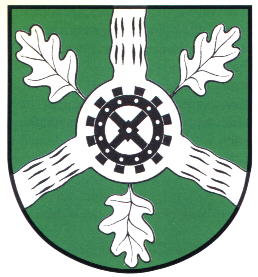Aumühle: Difference between revisions
Knorrepoes (talk | contribs) m (Text replacement - "{{de1}}↵" to "") |
Knorrepoes (talk | contribs) m (Text replacement - "{{media}}" to " {{de1}} {{media1}}") |
||
| Line 26: | Line 26: | ||
{{ | |||
{{de1}} | |||
{{media1}} | |||
[[Civic Heraldry Literature - Germany|'''Literature''']]: Reissmann, 1997 | [[Civic Heraldry Literature - Germany|'''Literature''']]: Reissmann, 1997 | ||
Revision as of 11:30, 26 December 2022
This page is part of the German heraldry portal Deutsche Wappensammlung |
Heraldry of the World |
|
German heraldry:
|
Selected collector's items from Germany:
|
AUMÜHLE
State : Schleswig-Holstein
District (Kreis) : Herzogtum Lauenburg
Amt : Amt Hohe Elbgeest (until 2008 Amt Aumühle-Wohltorf)
| German |
In Grün ein silberner Wellengöpel, belegt in seiner Gabelung mit einem schwarzen Mühlrad auf kreisrunder silberner Scheibe, die in den drei Winkeln des Göpels mit je einem silbernen Eichenblatt besteckt ist. |
| English | No blazon/translation known. Please click here to send your (heraldic !) blazon or translation |
Origin/meaning
The arms were granted on August 31, 1948.
The arms are partly canting. In the village the two rivers Au and Bille join and were historically used for energy using a water mill (Mühle). The two rivers and the mill are symbolised in the arms. The green colour and the oak leaves symbolise the many forests near the town. The oak leaves are also derived from the arms of the Bismarck family. The old estate of the famous Chancellor Bismarck, Friedrichsruh, is part of the municipality. Finally, the three oak leaves represent the villages Billenkamp, Aumühle and Friedrichsruh.
Literature: Reissmann, 1997


